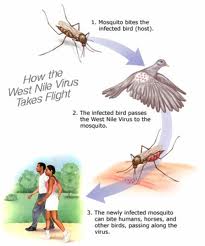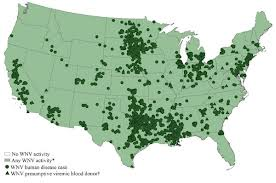With fall approaching and the weather starting to cool off, people are starting to spend more time outdoors. However, the news of West Nile virus in the US probably has you concerned about mosquito safety. But you don’t have to let these worries prevent you and your family from enjoying the beautiful weather outdoors. Some basic knowledge of the disease and tips about mosquito safety should ease your mind and help reduce exposure to mosquito bites.
The West Nile Virus
The disease caused by West Nile virus (WSN) is a potentially serious illness which occurs in North America flaring up in the summer and continuing into the fall. The illness has been around a long time in places like Africa, West Asia, and the Middle East but was reported in the US for the first time in 1999. The virus is spread by the bite of the Culex species of mosquito. These mosquitoes feed on infected birds and transmit the disease to other animals and humans through bites. The incubation period is 3 to 14 days. The virus multiplies in the bloodstream and if it reaches the brain, can cause infection of the nervous system, which is a serious complication called Encephalitis.
Spread of WNV
The West Nile Virus is spread by the bite of an infected mosquito. The virus is not spread by casual contact such as touching or kissing. In a small number of cases, the spread has been reported by blood transfusions, organ transplant, breastfeeding, and from infected mother to baby during pregnancy. If you see a dead bird in your area, do not handle the body with your bare hands as it may be infected with WNV. Contact the local or state health departments who will log the report and instruct you how to dispose of the body.
Symptoms of WNV
Only 1% of the mosquitoes in any area with carrier mosquitoes are actually infected with West Nile Virus. According to the CDC, about 80 % of those infected with WNV will not show any symptoms. Up to 20 % of the infected people will show mild symptoms of fever, headache, body aches, nausea, vomiting, and a skin rash that can last a few days to several weeks. Only about 1 in 150 people infected with the virus will develop an infection of the nervous system. People over the age of 50 are more prone to becoming sick if they get infected.
Cases in 2012
This year, as of September 4, 2012, there are about 1,993 cases of WNV disease in people, including 87 deaths, reported to the CDC. About 40% of these cases are from Texas, 25% of the cases were from South Dakota, Mississippi, Oklahoma, Michigan, and Louisiana. Of the 8 human West Nile cases in Missouri in 2012, 1 was fatal.
Treatment
There is no specific treatment for the disease. Milder infections usually resolve on their own after a few days or weeks of the symptoms. For more severe symptoms, people will need admission to the hospital for supportive care with hydration, nursing care and treatment of potential complications. Since it is a viral infection, antibiotics do not help. There is no vaccine currently available for WNV. Prevention is the most effective way to protect against the infection.
WNV Infection Prevention
It isn’t necessary to limit outdoor activity unless there is evidence of increased cases of mosquito-borne diseases in the area. However, you can and should reduce the risk of being bitten by mosquitoes. It is easy to remember the key tips for mosquito bite and WNV prevention by remembering the 5 Ds – Dawn & Dusk, Dress, Drain, and DEET.
5 D’s of Preventing Mosquito Bites
- DAWN & DUSK: Mosquitoes are most active at dusk and dawn, although some bite during the day, especially when you enter an area where they are resting, such as high grass or underbrush. If possible, try to avoid spending too much time outdoors at dawn and dusk.
- DRESS: When you are planning to be outdoors for an extended time, wear shoes, socks, long pants, and long-sleeved shirts. Tightly woven clothing is preferable since mosquitoes can bite through thin clothing.
- DRAIN: Mosquitoes breed by laying eggs in standing, non-chlorinated water. Reduce the amount of standing water in or around your property by draining or removing it.
- DEET: Mosquitoes are attracted to body odor and carbon-dioxide in your breath. Repellents do not kill mosquitoes but the active ingredients in the repellents make the person unattractive for feeding! Insect repellents containing N, N-diethyl-m-toluamide (DEET) or Picaridin have been registered with the Environmental Protection Agency (EPA) for safety and efficacy. Products containing oil of lemon eucalyptus, a plant-based repellent, are also registered with EPA and have been shown to provide protection similar to repellents with a low concentration of DEET. Always follow the product guidelines when using insect repellents.
Tips for Using Mosquito Repellents
- If you are planning to be outdoors for an extended time, use enough repellent to cover exposed skin and clothing. Do not apply repellent to covered skin under clothing or to cuts, wounds or irritated skin.
- Choose a repellent that provides protection for the amount of time that you will be outdoors. Higher concentration of the active ingredient is good if you are planning long hours outdoors. You can also reapply repellents sparingly if you are outside longer than expected.
- Heavy application of repellents is unnecessary.
- The EPA reports that DEET is safe for all children, however, kids should not use it on their own. When using repellent on a child, choose a product that contains no more than 30% concentration of DEET, since in higher concentrations, if the chemical is absorbed by the skin, it can be toxic.
- Apply repellents to your own hands and then apply them on your child. Avoid the child’s eyes, mouth, and hands. Children may tend to put their hands in their mouths.
- Do not use aerosol or pump products in enclosed areas or directly over the face.
- After returning indoors, wash treated skin with soap and water.
- If you suspect an allergic reaction to a product, discontinue use, wash the treated skin and call a poison control center. If product gets in your eye, flush with water and contact a healthcare provider or poison control center.
- You can use both a sunscreen and an insect repellent. The recommendation is to apply sunscreen first, followed by repellent. It’s recommended to AVOID using a product that combines DEET and sunscreen since instructions for use are different.
The CDC is working with local and state health agencies to prevent the spread of the West Nile Virus. For more information about the West Nile Virus disease and mosquito safety, visit the CDC website at: http://www.cdc.gov/ncidod/dvbid/westnile








This product is meekrtad as a natural product, but it is still as hazardous to humans. What’s the point in being natural then? The warnings in the back are just as scary as regular bug repellents that use DEET.Repel has a strong lemony smell, similar to Pledge I think. Although it is strong, and a bit distracting, the smell didn’t irritate my throat. Colognes and Perfumes usually irritate my throat, but not Repel.I don’t understand the logic behind an insect repellent being applied as a spray or pump. Each produces a fine mist that is very easy to get into your eyes, nose, or mouth whether indoors or outdoors. Considering all the warnings in the back about it being poisonous, I’m surprised these products exist in this form.I gave it two stars for those three things combined, but mostly for the third. Other than that it is an effective bug repellent. However, I’d much rather use some other repellent applied as a cream.
Nice tips for travellers. Prevention from mosquitoes bites is very important. We need to follow guideline for mosquitoes spread diseases.